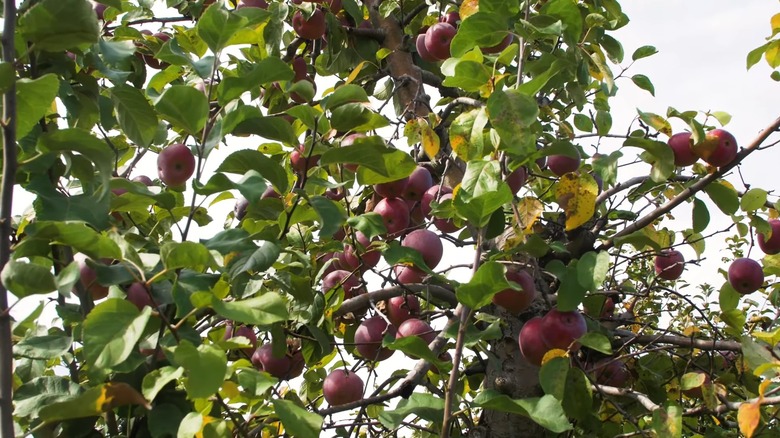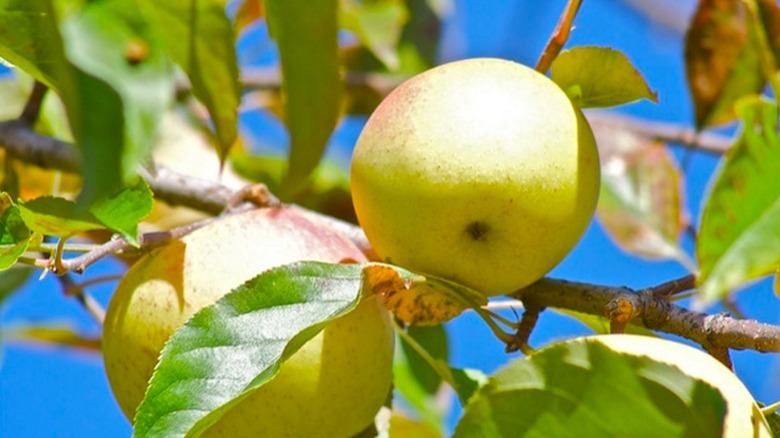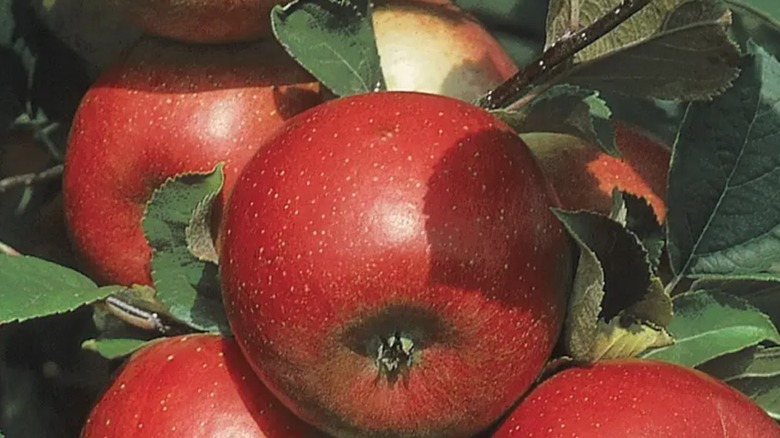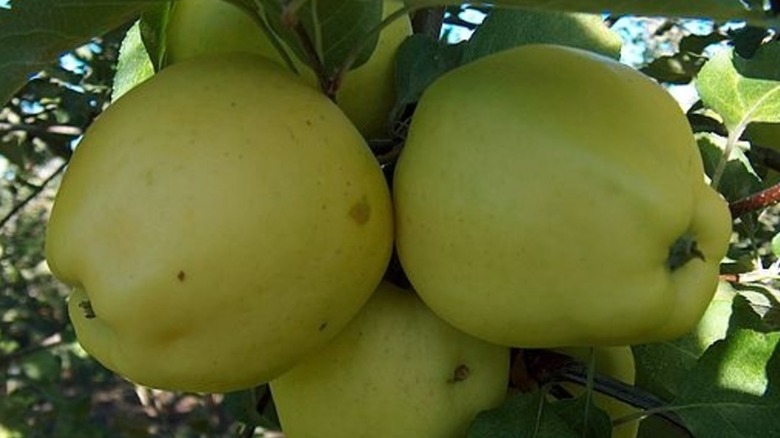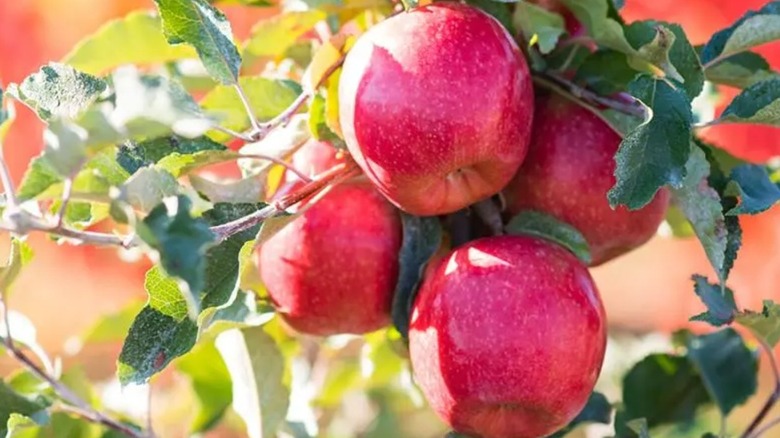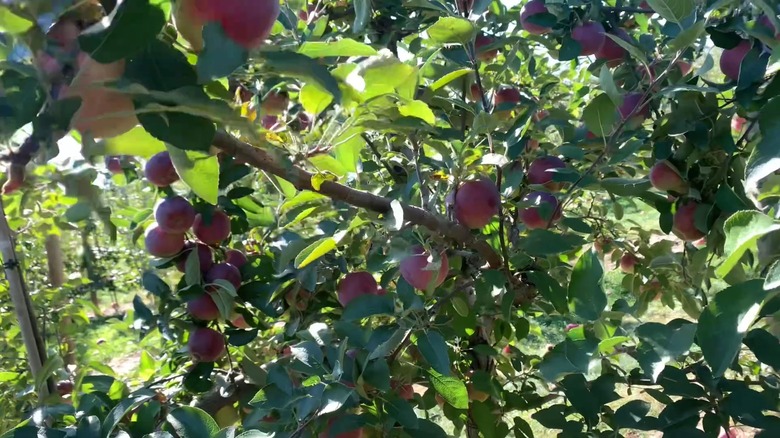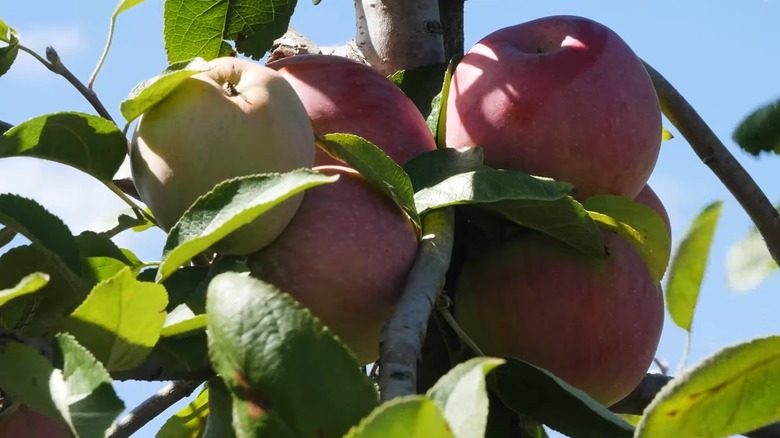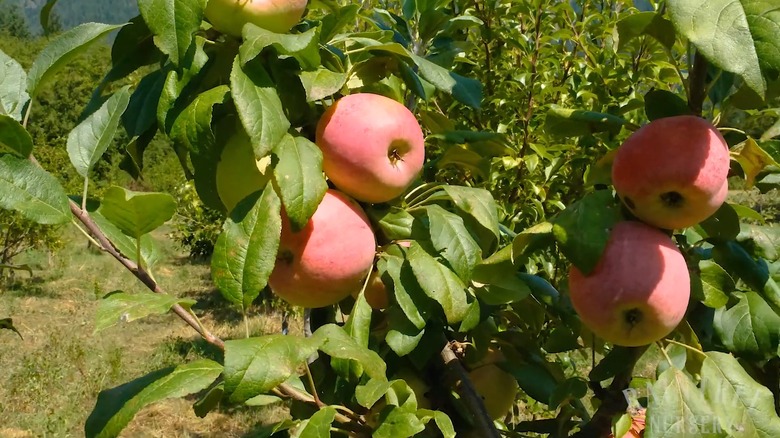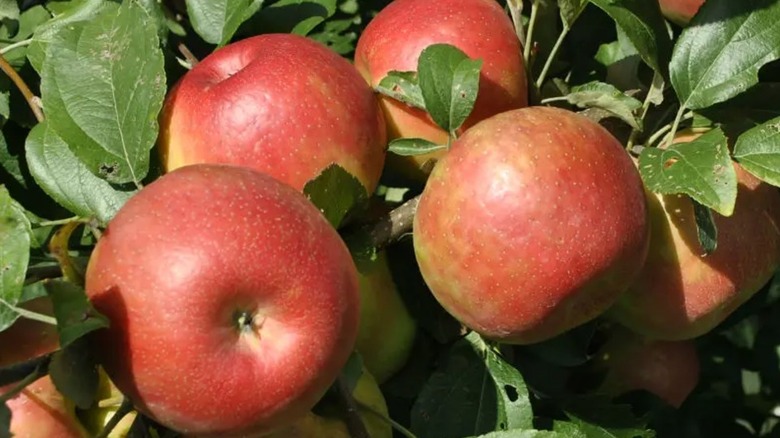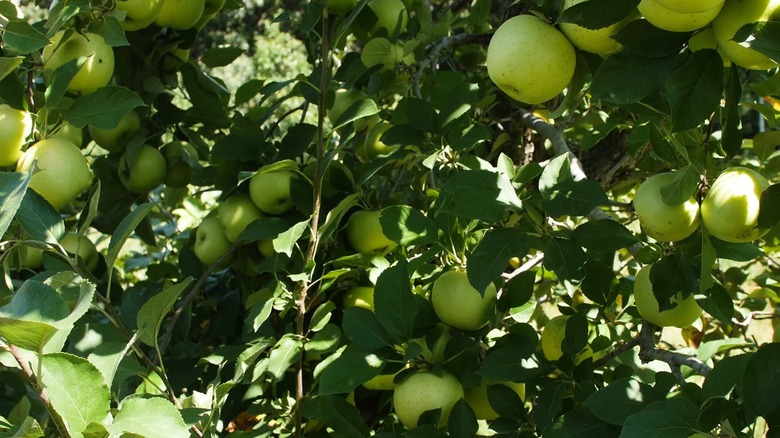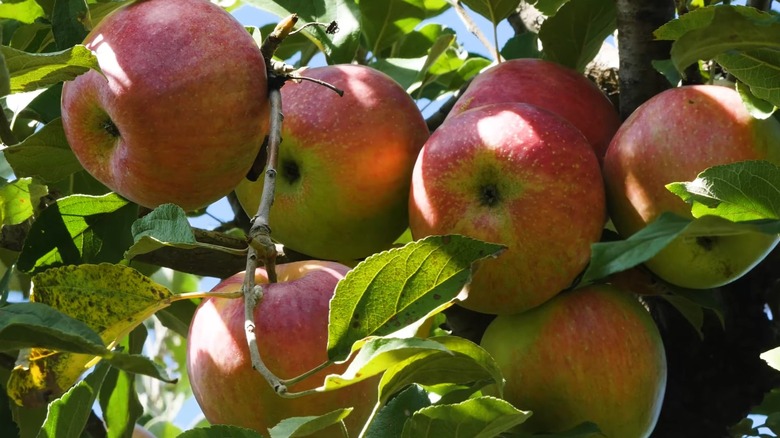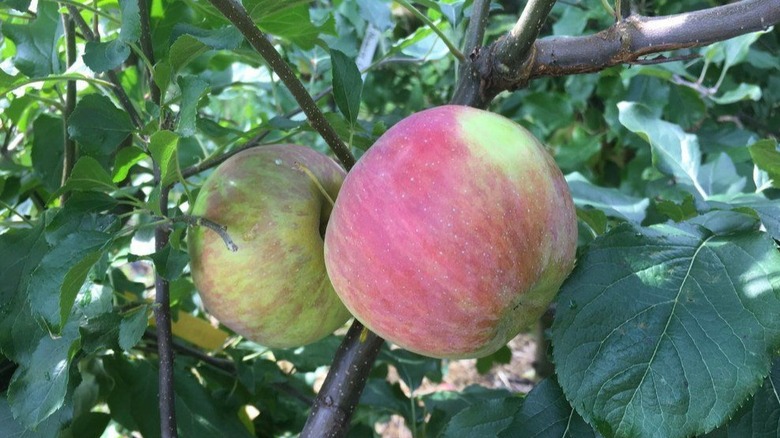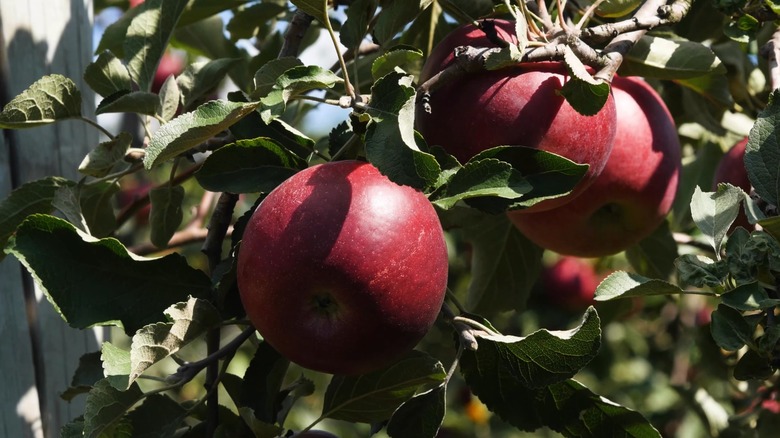The Best Apple Varieties You Can Grow That Are Great For Snacking
When you're snacking on apples, you expect them to fragment with a loud crunch, the flavors to explode in your mouth, and for the delectable juices to run down your chin. If your local supermarket's produce rarely offers such an experience, there is an alternative. Fortunately, you don't have to stray too far to get your hands on an apple worth its weight and dime — you can simply grow its tree in your backyard. Although it's difficult to build a consensus around flavors, as people seek varying levels of sweetness and tartness in their apples, one thing common to all the snacking apples is a crisp, juicy flesh. Varieties like 'Cortland,' 'KinderKrisp,' 'Liberty,' 'Golden Delicious,' 'Frostbite,' 'Pink Lady,' and many more deliver exactly that.
But before you set about growing your favorite apple variety at home, keep a few caveats in mind. Apple trees, including the dwarf varieties, often require lots of space. That's because they're not self-fertile and require a pollinating companion. In addition, you should aim to grow apple trees in an area where bees are regular visitors, or you may have to pollinate the flowers manually. Finally, while filtering out varieties on their hardiness zones and taste profiles, also pay attention to their susceptibility to diseases. If you're unsure of following a chemical regime to keep your trees disease-free, look for varieties resistant to the diseases prevalent in your area. Ready to grow your own snackable apples? Here are 22 different varieties to get you started.
KinderKrisp apple
Offspring of the highly-rated Honeycrisp variety, 'KinderKrisp' (Malus 'KinderKrisp') delivers the same taste profile with undertones of cinnamon and vanilla, albeit in a smaller package that can be safely tucked into lunch boxes. The sweet-tasting, crispy red apples taste best when plucked right off the tree, but can be stored for three months. These apple trees require between 10 and 15 feet of space, depending on whether you get the dwarf or semi-dwarf tree. Being an early-blooming variety, 'KinderKrisp' bears fruit by late August in US Hardiness Zones 3 through 7 and will require a pollinating companion.
Liberty apple
If you like 'McIntosh' apples but take offense to their soft skins, 'Liberty' apples (Malus 'Liberty') will have you elated. They offer a similar, well-balanced profile that's perfect for snacking, but the skins are firmer and don't bruise as easily. Additionally, 'Liberty' apple trees are resistant to several diseases, such as scab, mildew, cedar rust, and fire blight. They typically bear fruit in September and October, but you'll have to one-up the local deer to enjoy them. Liberty apples can be stored until Christmas without compromising on their quality. They successfully overwinter in zones 4 through 7.
Golden Delicious apple
Packing slight spicy notes in an otherwise crispy and juicy fruit, the 'Golden Delicious' apple (Malus domestica 'Golden Delicious') is another variety you would enjoy gorging on. The large, pale green-skinned apple turns a sun-kissed yellow when it ripens in the fall. But because it's a prolific producer, you'll be left with plenty of extra fruit that you may turn into delicious apple butter. 'Golden Delicious' doesn't require a pollinating companion, but providing one like 'Honeycrisp' will certainly boost your yield. Zones 4 through 9 are its adaptive range. You may have to spray the trees for scab and canker.
Frostbite apple
Gardeners in zone 3b who lament the limited availability of sweet apples will delight in the juicy goodness of 'Frostbite' apples, or MN 447. Not only can this variety brave temperature dips to minus 30 degrees Fahrenheit, but it also displays some resistance to apple scab. Yellow-dappled, maroon-red apples, borne from September end to mid-October, are small enough to fit into kiddie hands for immediate consumption and surpass sugarcanes in sweetness. Excessive produce may be refrigerated for up to four months. 'Frostbite' apples are easily bruised and may draw in wasps to your garden.
CrimsonCrisp apple
Staying true to their name, 'CrimsonCrisp' apples have a bright red skin that's crispy enough to crackle with an audible crunch when bitten. Every bite carries the undertones of honeyed caramel, making it an absolute delight for mindless snacking. They may also be stored for future consumption for four to six months. Also sold as Co-op 39, 'CrimsonCrisp' apple trees are cold-hardy in zones 5 through 8. While they're highly resistant to apple scab, other diseases like mildew and fire blight may affect them. Use 'Honeycrisp' or 'Freedom' as pollinating companions.
Freedom apple
Named so due to its near-immunity to the dreaded apple scab disease, the 'Freedom' variety is excellent for home gardens because it reduces the need for chemical treatments. It can also withstand powdery mildew, canker, rot, and cedar-apple rust to a limited extent. The yellow-flushed, red apples can be harvested in late September for snacking, while the extras can be refrigerated for up to three months. 'Freedom' apple trees are available in dwarf and semi-dwarf sizes and are perennials in zones 4 through 8. Pair them with 'Cortland' or 'Liberty' for cross-pollination.
Ginger Gold apple
Since 'Ginger Gold' apple (Malus domestica 'Ginger Gold') trees can handle heat, they can bear fruit sooner than most of their counterparts, which is usually around July or August. The fruits are greenish-yellow when ripe and have a mild, sweet taste that's enjoyed fresh off the tree or peppered in salads. 'Ginger Gold' apples can grow 12 to 15 feet tall and will require an early-blooming variety like 'Honeycrisp' or crabapple trees for cross-pollination. Plant in full sun in well-draining soils, as they're susceptible to powdery mildew.
Fuji apple
'Fuji' apple trees (Malus domestica 'Fuji') are quite the find on account of their fruiting and visual appeal. During spring, their tall frame is clothed in pinkish-white blooms that hummingbirds and butterflies find irresistible. By fall, the flowers make way for burgundy-red apples that, despite their thick skin, taste devilishly sweet. Better yet, you can store them for up to six months in the refrigerator. 'Fuji' apples reach their fruit-bearing age after three years of planting. To help your fruit trees grow and produce faster, plant them in full sun. 'Fuji' apples grow well in zones 5 through 8.
Pink Lady apple
Also sold as 'Cripps Pink,' 'Pink Lady' apple trees are more suited to southern climes. That's because they bear fruit in October, and up north, the growing season may not be long enough to allow the fruit to ripen, even though these trees are hardy in zones 5 to 8. 'Pink Lady' apples have a nice crunch, tasting tart on the first bite, but finishing on a sweet note. They're also very ornamental, boasting white dots all over thick reddish-pink skins. As they're self-infertile, pair them with 'Granny Smith' or 'Red Delicious' for cross-fertilization.
Empire apple
'Empire' apples are highly versatile, as they can be readily munched or baked into pies. The green-fleshed, red apples are crunchy and juicy, and hold well in storage — three months if refrigerated. 'Empire' apple trees (Malus domestica 'Empire') grow about 15 feet tall and just as wide, and can fit in small yards. However, you must couple them with a pollinating companion that blooms around the same time in spring. 'Red Delicious' is one such option. Although resistant to cedar-apple rust and fire blight, 'Empire' apple trees are susceptible to mildew and scab diseases and will require the necessary care.
Red Delicious apple
Hardy in zones 5 through 8, 'Red Delicious' apple (Malus domestica 'Red Delicious') trees are available in different habits, from dwarf to standard. While this is convenient for homeowners as they can choose the plant that fits their space best, it also means you must look for similarly-sized companions for fruiting. 'Red Delicious' apples have a mild, sweet taste, agreeable enough to snack on or save for later consumption, given that they hold their shape and flavor in storage. As they grow upwards of 2 feet every year, you can give these fast-growing fruit trees a home in your yard for quick results.
Cortland apple
Hardy through zone 4, 'Cortland' (Malus domestica 'Cortland') is a 15-foot-tall apple tree that's best grown in cool climates. After terminating its spring blooms, the tree produces tasty fruits clothed in yellow and red streaks. If ripened on the tree, purple spots may develop on the fruits where they were most exposed to the sun. These juicy, sweet apples are a staple in fruit plates and salads because they take a while to turn brown after slicing. Since they're borne during September, grow an early or mid-blooming variety, like 'KinderKrisp,' for cross-pollination.
Stayman Winesap apple
If you would like a snackable treat that you can enjoy for several months, six in this case, consider growing 'Stayman Winesap' apples (Malus domestica 'Stayman'). Despite their thick skins, they're well-liked for their balanced profile with overtones of wine. As they grow slowly, it's best to plant their dwarf cultivars, which take about four years to bear fruit — for standard specimens, you may have to wait for a decade before you see any apples. In frost-free climates, they continuously produce flushes of fruit, but are limited to fall, elsewhere in zones 5 through 8.
Zestar! apple
Tired of waiting until the fall to gorge on crunchy apples? With 'Zestar!' you won't have to. An early bloomer, the 'Zestar!' apple tree is ripe for picking in early September, and it doesn't taste mealy. The green-spotted, red fruits have a well-balanced flavor with notes of brown sugar. But if you'd like to up the sugar content, maximize the sun exposure. 'Zestar!' can hold its crunch for hours on end in tiffin boxes and nearly two months in your refrigerator. Although vulnerable to apple scab, it resists fire blight. Grow these apple trees through zone 4.
Honeycrisp apple
You're probably no stranger to 'Honeycrisp' apples, as they're ubiquitous in supermarkets. However, with a solid spray regime in place, you can grow them in your home garden for tasty, crunchy treats, starting in September. If refrigerated, you can enjoy the produce for another seven months! 'Honeycrisp' apple trees can be grown in zones 3 through 8 and require a mid- or late-blooming apple variety, like 'Golden Delicious' or 'Red Delicious,' for cross-pollination. They're resistant to apple scab. In confined spaces, stick to dwarf varieties that grow between 8 and 10 feet tall and across.
Prairie Magic apple
'Prairie Magic' apple tree (Malus x 'Prairie Magic') isn't the fastest of the lot, given that it only adds about 14 inches in a year — at its best — and can take over three years to reach the fruit-producing stage. However, once it starts bearing, it's an absolute delight. Its fruits are large and delectably juicy, with a nice crunch. They taste sweet even if you harvest them semi-ripe during August. Excessive produce can be refrigerated for up to three months. 'Prairie Magic' apple trees are extremely cold-hardy and can be grown in zones 3 through 7.
Pixie Crunch apple
As their name suggests, 'Pixie Crunch' apple trees produce pixie-sized, tiny apples that are easily gobbled down during lunch break. What makes them even better is that they're as crispy as the 'Honeysuckle' variety — on and off the tree. Since they hold well to the branches without going mushy, you can continue to harvest them for over three weeks during September. Afterward, you can store them in a cool environment for two months. 'Pixie Crunch' apple trees remain untouched by apple scab and fire blight but aren't as lucky in the face of rust and mildew. Grow them in zones 5 to 8.
Honeygold apple
If you live in zone 3 and are bummed about being unable to grow 'Golden Delicious' apple trees, rejoice. As they can withstand up to minus 50 degrees Fahrenheit, 'Honeygold' apple (Malus 'Honeygold') trees are hardy to your zone and offer the same honeyed, crispy profile. They're partially self-fertile and so don't necessarily need a pollinator, though they do benefit from one. In storage, these bronze-blushed, yellow apples keep well for over two months. Unfortunately, they can take over four planting years to reach the fruit-bearing stage and are also vulnerable to fire blight and scab.
Sweet Sixteen apple
For a complex profile, grow 'Sweet Sixteen' apple trees (Malus 'Sweet Sixteen'). A single bite expresses overtones of spicy anise, sweet cherry, and vanilla, and is crunchy, to boot. However, to some, the red-striped, yellow skin can seem unreasonably thick. 'Sweet Sixteen' apples are delicious, even if broken free of their limbs early in the season. They're also great for storage and can hold their own for nearly eight weeks. These apple trees are cold-hardy up to zone 3b and can withstand fire blight and scab to a limited extent.
Sundance apple
Those who enjoy a mild tartness in their fruit would love 'Sundance' apples. These yellow-skinned apples are flavorfully spicy, though their acidity softens after refrigeration, which they can tolerate for nearly five months! 'Sundance' apples are fairly easy to maintain, as they withstand the most gruesome apple diseases, including scab and blight. However, to ensure you aren't facing a biennial crop, where the tree produces prolifically in alternate seasons, you must thin the crop every year. 'Sundance' apple trees' low chill requirements of 500 hours make them valuable in southern landscapes, though their overall range covers zones 5 to 8.
NovaSpy apple
Fans of 'Northern Spy' apples should switch over to 'NovaSpy' apples if they're looking for a sumptuous snack that isn't half as difficult to grow. Unlike their parents, 'NovaSpy' apple trees are far more productive and resilient against fire blight and scab. In addition, the yellow-mottled, pinkish-red fruits deliver a more balanced profile, as they also carry 'Golden Delicious' vanilla sweetness. Available from mid-October, these fruits can be stored for over three months. These trees can grow to about 18 feet tall and are cold-hardy in zones 3 to 7.
Jonathan apple
In small gardens, consider growing 'Jonathan' apple trees. These max out at 8 feet and are self-fertile, and thus, don't require much space. They're also resistant to leaf blotch and brown rot, though they remain partially vulnerable to other diseases. Given their prolific production, it's important to thin their crop every year to ensure the tree remains vigorous. 'Jonathan' apples look unique with strands of green and yellow running across their red skin. However, they certainly taste sweet and juicy, and your kids will delight in their crunchy texture. Their heirloom apples can be grown in zones 5 through 8.


